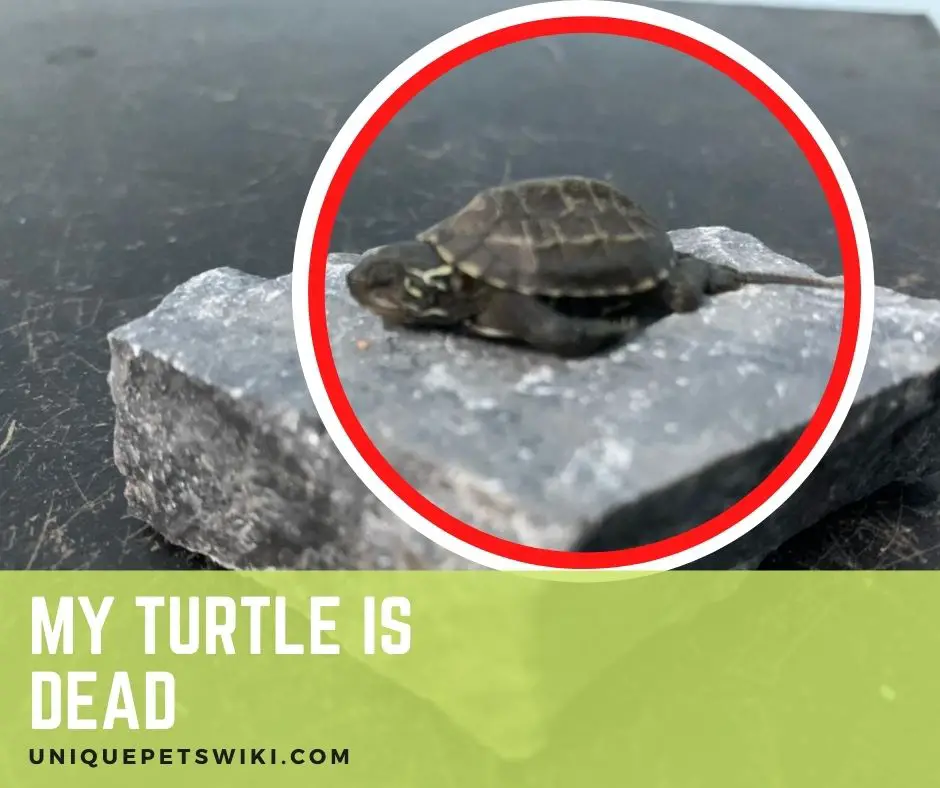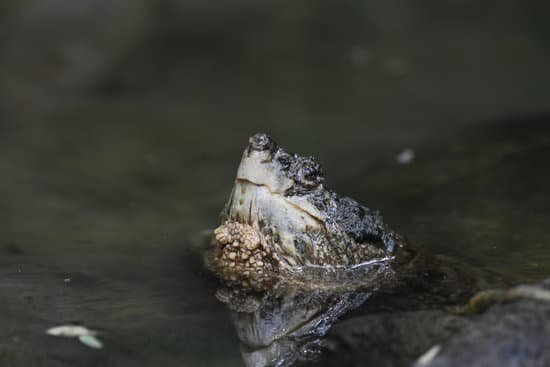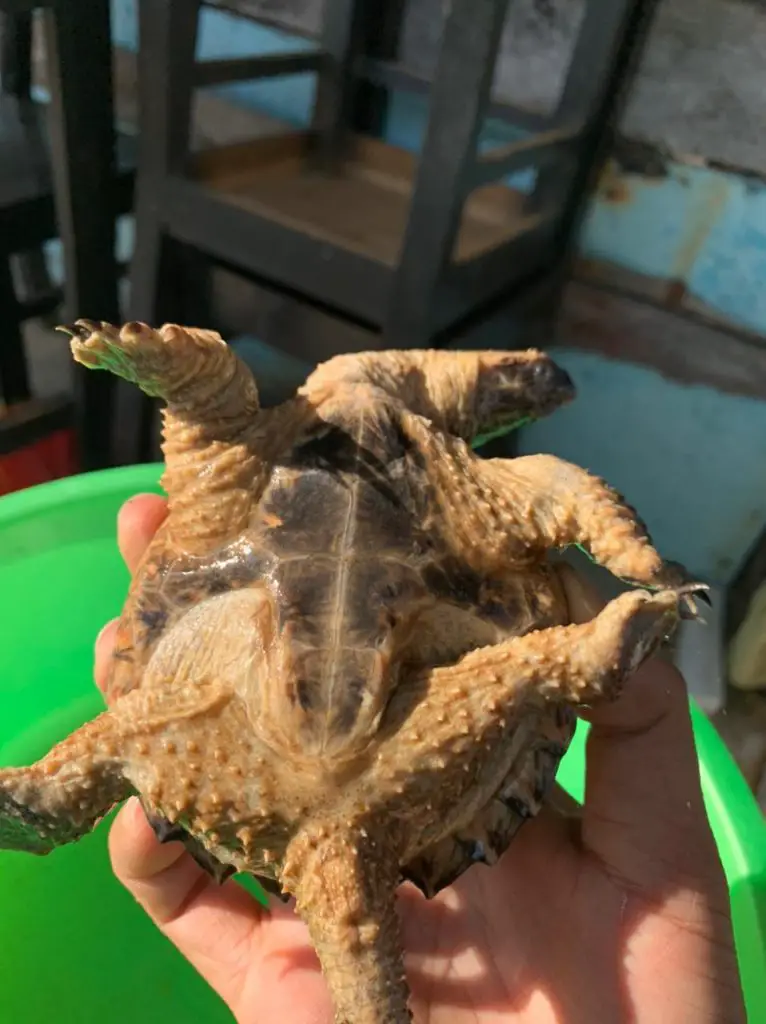You’re here because you think your turtle may be dying but you don’t know. Nothing to worry about.
This article will take you through all the sick and dying symptoms of a turtle, what causes the sicknesses and what you can do to help your pet turtle.
Of all the different species of reptile animals, aquatic turtles are the most demanding to care for. As difficult as caring for them may seem, some reptile enthusiasts still find them fascinating to keep as pets.
Some keepers go into caring for these animals with little or no knowledge about them. Which explains why they make mistakes in their husbandry.
Nevertheless, we now have many useful articles on how to care for pet turtles which you can take advantage of to be a good keeper to your pet.
Some of these articles such as snapping turtle care are a must-read for you to better understand why your pet turtle is having those signs and where you may have gone wrong in its upkeep.
After reading this article, you will be able to remedy the ill situation your turtle is in and you’ll also know how to prevent future occurrences by optimizing your husbandry/care. Keep reading to the end.
Contents
Signs A Turtle Is Dying

A living turtle will typically respond to stimulus no matter how sick, but a dying turtle will appear numb, float sideways in the water, and emit a foul smell. Other signs include:
- Lethargy, when it isn’t winter time.
- Swollen eyes, especially with a pus-like discharge.
- Runny nose.
- Loss of appetite for a long time.
- Ear abscess. Usually with a pus-like discharge and bad smell.
- Excessive basking.
All of these symptoms are signs that your turtle is in a terrible condition that needs urgent medical attention. The reason you’ll need to see a vet first before treatment is to avoid giving wrong treatments to your animal for a particular disease.
Captive turtles, especially aquatic ones are mostly affected by infectious diseases which are caused by either bacteria, viruses, or vitamin A deficiency. However, most of the time, diseases such as respiratory infections are caused by bacteria and viruses.
In the case of respiratory infections, vitamin A deficiency is often a secondary cause. On the flip side, diseases such as ear abscesses are more a result of vitamin A deficiency.
As mentioned above, it’s evident that the causes of diseases in captive turtles are husbandry-related. It can be either or all of these mistakes: wrong habitat set up, wrong temperature, poor hygiene, and poor dieting.
Since these animals can mask an illness, the ideal way to enhance its lifespan is to prevent these diseases by improving husbandry. Read on to find out more tips.
How To Tell If Your Turtle Is Sick Or Dying
Whether you’re an experienced keeper or just a newbie, there are ways to tell between normal and abnormal behaviors.

You will be able to notice if your turtle is sick and maybe dying if it exhibits behaviors that are not normal.
These behaviors include but are not limited to symptoms that have been mentioned above. Note that as discussed earlier, most of these symptoms are not illnesses, but signs of an underlying disease.
As with every reptile animal in captivity, the root cause of diseases and sickness is the fault of their habitat.
Just as low temperatures and high humidity levels will cause health issues to desert-dwelling reptiles, many of the common health issues affecting pet aquatic turtles are habitat-related.
Since turtles are water-dwelling animals, they tend to suffer from parasitic infection, respiratory infection, and malnutrition the most.
In most cases, dehydration can also be the reason your turtle is dying. As stated earlier, to tell if your turtle is sick or dying you must understand the symptoms and what they mean.
That said, the next section will discuss in detail all sick and dying symptoms of captive turtles, the causes, and what you can do to save your turtle.
8 Signs Of A Sick Turtle
Let’s remind you that it’s a lot of work to care for turtles in captivity. Some of these animals are aquatic. But since they have no gills to let them breathe in the water, they usually swim out to breathe for some time before diving back in the water.
This means that most of their time is spent in the water. This means that if their habitat isn’t kept clean and within appropriate temperatures, serious health issues may occur.
To worsen the situation, turtles do not show symptoms of illnesses or diseases at an early stage. They can conceal the symptoms for as long as they can only for the illness to be seen when it is very critical.
For this reason, you must have the habit of regularly examining your turtle to be sure it’s free of disease. That said, here are signs and symptoms to look for to know that your turtle needs medical attention.
Lethargy Or Prolonged Inactivity Level

One key sign of a healthy turtle is high activity level. It’s normal behavior for your turtle to move around its tank in response to its habitat such as feeding, heating up or cooling down, and interacting with you as its owner.
However, when your turtle shows lethargic tendencies (symptoms of inactivity) coupled with other symptoms such as having trouble swimming, it’s something to worry about. Once you notice this, examine your pet immediately to know what is wrong with it.
Loss Of Appetite
Inactivity most often comes with a loss of appetite. This is one of the first and most common signs of any disease. The disease can be an obstruction of their gastrointestinal tract or an internal infection that makes the animal lose interest in food.
Whatever is the case, when your turtle isn’t eating for some time, it’s not something to be taken lightly. In some cases, females who have difficulty laying eggs will also lose appetite for food.
To ensure that your turtle does not lose weight to the point of dying, find out why it is not eating and address the problem before it gets out of hand.
Breathing Problems Or Gasping For Air
One of the most common diseases that affect captive turtles is a respiratory infection. It is a bacterial infectious disease that affects the lungs caused by excessive moisture.
It is usually characterized by these signs: – wheezing, sneezing, and gasping for air. Sneezing and wheezing can be signs of mild respiratory infectious attacks.
However, severe cases of respiratory infection are usually accompanied by breathing difficulty (gasping for air or breathing with the mouth open).
Bubbles Or Pus-Like Discharge From The Nose/Mouth
A pus-like discharge (mucus) or bubbles coming out from either of your turtle’s mouth, nose, eyes, ears are a sign of a serious disease. This mucus is an illness called ‘bubbling’ and it’s a sign of a respiratory infection.
Besides respiratory infection, the intensity and where the discharge is coming from also suggests what is wrong with the animal.
If the pus-like discharge is thick and is coming out from the ears and eyes with swollen eyelids or ears, then it is a sign of vitamin A deficiency. In that case, you need to supplement your turtle’s diet with vitamin A.
However, note that not all cases of swollen eyelids and ears accompanied by thick pus-like discharge are a sign of vitamin A deficiency. Some are more serious cases of viral or bacterial infection and or exposure to excessively strong UVB light.
To rule this out, a turtle that has been on a proper diet with adequate vitamin A wouldn’t be suffering from vitamin A deficiency.
Lopsided Swimming Or Buoyancy (Floating Sideways In The Water)
By nature, turtles are swimmers and good ones at that.
Hence, when you see your turtle having trouble swimming, tilting to one side or lopsided swimming, floating in the water, or showing any other disorientation while in the water, it is an indication that something is wrong with your turtle and needs medical attention immediately.
Sometimes floating in the water isn’t a surefire sign that your turtle is sick because they do that a lot when they’re healthy. However, if the buoyancy is accompanied by no response to stimulus then it’s a sign your turtle is dying.
Source: https://www.reddit.com/r/turtle/comments/h93691/turtle_is_swimming_lopsided_and_has_difficulty/
Dehydration
You might be wondering if aquatic turtles do suffer from dehydration. Yes, they do. If they’ve been out of water for a long time for any reason such as relocation or shipping, they can get dehydrated.
It’s important that your aquatic turtles have access to fresh and clean water at all times to stay hydrated. Other than this, dehydration can lead to some health issues.
For terrestrial turtles suffering from dehydration, spray some fresh, clean water on the vegetables you intend to feed to them to increase their water consumption.
Diarrhea, Green Or Bloody Poops
This in turtles is a sign of parasitic infections, destruction of the digestive tract, or any other organ damage.
For your turtle to show these signs means that the disease has been there for some time.
Proper medical diagnosis is required before any treatment is given.
Holes On The Shell Or Shell Rot
What causes shell rot are either parasites, fungi, or bacteria. Burns, trauma, and bites can also cause shell/skin problems but these are secondary. Infections affecting the scale can make any part of the turtle’s body swell.
You may also see open wounds, tumors, and lesions. Like with other symptoms, this should be treated by a vet.
Can You Treat A Sick Turtle?
Most of the diseases affecting captive turtles, especially aquatic turtles are bacterial and viral infections. Only a few cases are caused by vitamin A deficiency.

To avoid complications, these infections are better diagnosed and treated by an experienced vet. This will help the vet to know what type of infection is affecting the turtle and what medication to give.
However, depending on what type of infection and where the symptoms are coming from, you can administer some treatment at home.
To safely do this you’ll need at least these six (6) items:
- Dechlorinating formula.
- A calcium block.
- A sizable empty container or aquarium.
- A UVB bulb.
- A heating pad or any other heat source.
- A thermometer for regulating temperature.
What Should You DO?
- Using the empty tank, heater, and UVB bulb, set up a temporary habitat for the infected turtle.
- Fill the tank with at least 3inches of water. Depending on what size and species your turtle is, ensure that the water is enough to cover the turtle’s whole body.
- Once you are satisfied with the water level in the tank, place the tank on the heat pad to warm it to the appropriate temperature for your turtle.
Note that different species of turtles require different temperatures. Thus, be sure you set the temperature to what is ideal for your species.
- Connect a UVB source to the tank.
- Check with a thermometer to ensure that every habitat rule is adhered to. The temperature should not be higher than 86 F nor lower than 82 F.
- Add at least a drop of dechlorinating formula to the water or more depending on the severity of the infection.
- Place the calcium block in the water before introducing your turtle to the habitat.
- While your turtle is going through this dechlorinating water treatment, ensure to change the water twice a day and check with your thermometer at each time to ensure that the temperature is within the ideal level.
- Repeat this till your turtle is completely healed of the infection before returning it to its usual enclosure.
Abscesses
The two main causes of abscesses are infection and lack of vitamin A. But many cases are caused by vitamin A deficiency than infection.
Since vitamin A deficiency is often the cause of abscesses, the best way to treat or prevent it is to improve your diet and offer rich vitamin A foods to your turtle.
In some cases, a few drops of vitamin A can be given orally or through injection. This method will only work if you notice the abscess in time before it becomes worse.
CAUTION: We usually advise that treatment of abscesses or vitamin A deficiency should be done under your vet’s supervision. You can run a test to be sure that the cause of the abscess is vitamin A deficiency.
The effect of overdosing your turtle with vitamin A is that it’ll result in hypervitaminosis A.
Ill Symptoms That You Can Treat At Home

Many diseases in turtles are not something you should try treating yourself without first consulting your vet.
The importance of proper diagnosis and medication cannot be overstated. Giving the wrong treatment and treating your pet late have negative impacts on the turtle’s health.
While some symptoms such as ear abscesses may require some vitamin A supplementation, do your due diligence as a good keeper and get your pet tested. From the result, proper treatment can be given.
When Do You Need A Vet?
You need to see a vet immediately if you notice that something is wrong with your turtle. A late response to your turtle’s illness signs is often why captive turtles die before getting to see the vet.
Keep in mind that you’ll likely not see the signs of the illness when it started. Thus how fast you act to see the vet can determine whether your turtle will die or survive the illness.
Severe cases of abscesses need medical attention. To save your pet, your vet will not only give oral/injectable antibiotics or topical medication, but he will also treat it surgically by opening and draining out the pus with a medicated cleansing solution.
Ideally, the affected tissue causing the pus is also flushed out in the process.
Symptoms That You Need A Vet
With almost all symptoms and abnormalities you notice in your turtle are worth seeing a vet. These symptoms include:
- Swelling of the ear and eyelids, especially with a pus-like discharge.
- Breathing difficulty or extending the neck to breathe.
- Nasal discharge or bubbles in the mouth, eyes, and nose.
- Floating or lopsided swimming.
- Gasping for air. That is breathing with the mouth open.
- Diarrhea.
How To Help Prevent Sickness In Turtles
Good husbandry and proper diet are the two most important factors that must not be compromised in your care for your captive turtles. These animals are long-lived but if your husbandry is faulty, you’ll lose them sooner than you expected.
Almost all diseases affecting them in captivity are related to poor hygiene and poor dieting. On that note, below are a few tips to help you optimize your care:
- Proper Nutrition: From our discussion in this article, it is clear that lack of vitamin A can cause some infectious diseases in aquatic turtles.
Placing your turtle on an all-meat diet or iceberg lettuce and other poor-quality food will result in hypovitaminosis A. It is a condition where your turtle lacks sufficient vitamin A required for its good health.
That said, ensure you’re feeding your turtles the right foods and in the right quantity.
- Always maintain good hygiene especially in the water area of the terrarium. Ensure you filter out waste regularly from the water.
- Do not use tap water for your aquatic turtles because of the chlorine and fluoride content in tap water. These chemicals usually affect the PH balance of the water and will affect your turtle in the eyes.
- Always ensure that the water in the tank is fresh and clean.
- Have a regular clean-up routine to ensure that your turtle’s tank is kept clean at all times.
- Maintain an appropriate temperature and humidity level in the cage. Have a thermometer to measure and keep the records.
- Regularly weigh and record the weight of your pet turtle. This way, you can tell that your turtle is sick if there’s a significant weight loss from the records you have.
- from time to time check to ensure that your heating, lighting, and UVB lights are functioning appropriately.
- Read more about the species of your turtle and its captive requirements.
Wrapping Up
Reptiles are an unpredictable set of animals. One moment they are fine and the next minute they are sick. They have the habit of going from 0% illness to 60% illness because they can mask the sickness.
This is especially the case with turtles. Therefore, when you suspect that your turtle is sick, act fast to save it or it will be too late. Time is of the essence in caring for captive aquatic turtles.
Since they can’t run a fever as humans or other mammals do, it’ll be difficult to tell when they are sick at the right time, if you don’t have a habit of examining their behaviors regularly.
As hinted earlier, one of the ways you can help your turtle recover faster is to place it where it is warm and ensure it basks well.
Since they can live without water for a couple of days, when they’re sick do not keep them in the water. This will help the turtle to heal faster.
